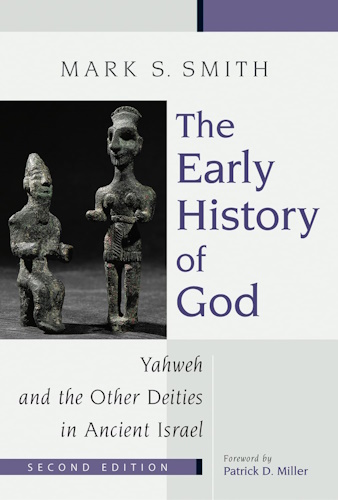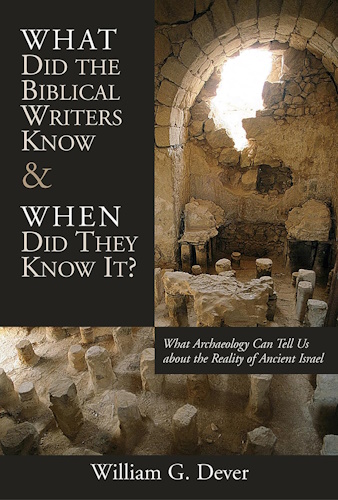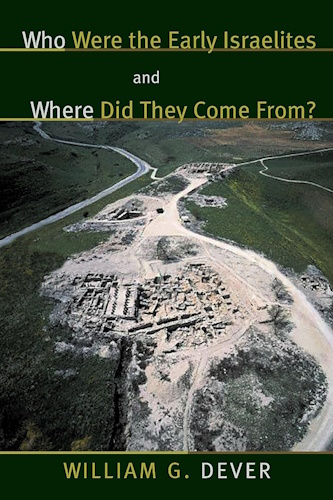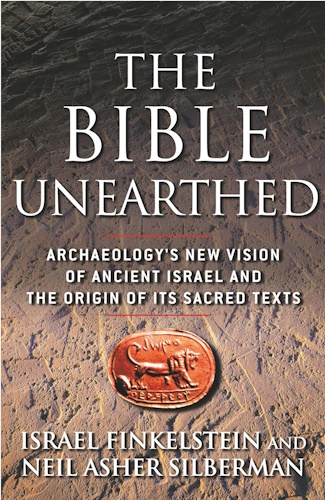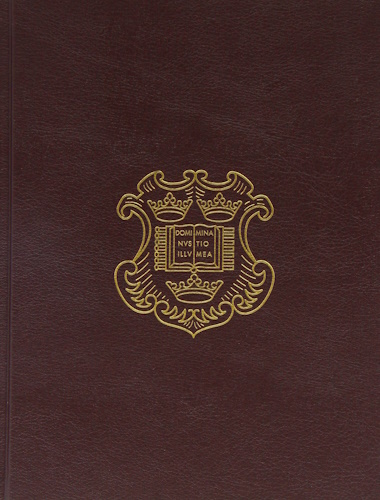![]()
The Evolution of God
from
The Unspoken Bible
[I find the author's remark, "There is enough information on this site to convince all but hardened theists that the Bible should be retired to its rightful place next to pagan mythology" disparaging against those who believe in God (theists). There are mistakes, deletions, and word ballet that has occured, and I do believe we have a 'deep state' consortium hell bent on discrediting religion and faith, but to relegate its great historical written works to the realm of "pagan mythology" is irresponsible. ~GBA]
![]()
Most people can't think,
most of the remainder won't think,
the small fraction who do think
mostly can't do it very well.
The extremely tiny fraction who think regularly,
accurately,
creatively,
and without self-delusion
- in the long run,
these are the only people who count.
- Robert Heinlein

The Demidoff Altarpiece by Carlo Crivelli
Does God exist? Believers take a great degree of comfort that their claims for the existence of God cannot be disproved. They might be ignorant of scientific reason or be making a bluff defense knowing that scientific reasoning is based on observation. Science cannot directly “disprove” the existence of God, simply because there is no physical evidence upon which to base a “disproof.”
Rather than take that approach, scientific reasoning drives out erroneous ideas when stronger evidence points to better explanations. While Christians impugn the word “theory” as if it represents a great deal of doubt, in the science lexicon, it is a way of expressing science’s open-endedness. In comparison, while religionists are certain of their faith, the word epitomizes belief without evidence despite the many evidential contradictions that make faith problematical.
We will leave aside the argument against the existence of god in the generic sense. A generic god cannot be defined. The word could mean almost anything within the limits of human imagination. Even the currently faddish explanation, Intelligent Design, tells us nothing of the attributes of this so-called form of intelligence. The hope among proponents is that believers will translate the idea to their favorite personal God.
Scientific reasoning avoids that trap by binding itself to observable evidence. With regards to cosmology, it can’t be known if the universe had a beginning. The famous Big Bang Theory only suggests a cosmic explosion 10-20 billion years ago. Even NASA modestly admits:

"Although the Big Bang Theory is widely accepted, it probably will never be proven; consequently, leaving a number of tough, unanswered questions."
Suppose there is an infinite universe. By definition it can’t be seen. The Big Bang, if it is true, may only have been an explosion within a universe with no beginning and no end. Or to say it another way, existence always existed. Science does not rise or fall on whether existence had a beginning or not. Mainstream religion’s credibility cannot tolerate this ambiguity.
For that, we will turn our attention to the beginning of “God,” the proper noun; when did god become God? Mainstream religions place no credibility in heathen religions, yet their very foundation rests on them. If “God” had a beginning, archeological and historical evidence points to the polytheistic religions that preceded and paralleled the rise of Judaism and early Christianity. Religionists could argue that belief in a single God was a refinement of all the other ideas. The problem with that assertion is that without something concrete to guide the direction of their logic, there are as many explanations for the existence of a God or god(s) as human minds can imagine.
Fortunately, we have two concrete sources from which to trace the evolution of God: archeology and the Bible. By that route, this report will show that Israelite religion branched off from the Canaanite religions. The Israelites were not monotheists; they were henotheists, which mean that their culture was defined by their worship of Yahweh as their only god, but they did not deny the existence of other gods. During their earliest history they also worshipped El, from which their namesake derived, and Baal and Asherah. The idea of a single exclusive God didn’t enter Hebrew culture until the Babylonian exile. By extension, this is the false foundation on which Christianity and Islam rest.
The ancient Israelites did not live in a cultural vacuum. From prehistoric times, Canaan was linked to Egypt and Mesopotamia. Those two powerful nations dominated Canaan and Israel from the mid-third to the first millennium BCE. The first mention of Israel comes from an inscribed monument of the pharaoh Merneptah. This stele dates to the fifth year of the pharaoh’s reign (ca. 1208) and mentions both Israel and Canaan.
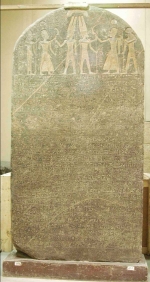
The princes are prostrate, saying: “Mercy!”
No one raises his head among the Nine Bows.
Desolation is for ‘Tehenu; Hatis is pacified;
Plundered is the Canaan with every evil;
Carried off is Ashelon; seized upon is Gezer;
Yanoam is made as that which does not exist;
Israel is laid waste, his seed is not;
Hurru is become a widow for Egypt;
All lands together, they are pacified;
Everyone who is restless, he has been bound.
Surely, the Israelites were late comers to the history of religion. Says Smith, author of The Early History of God: Yahweh and the Other Deities in Ancient Israel (Biblical Resource Series), “The word ‘Canaan’ is written with a special linguistic feature called a determinative, denoting land. ‘Israel’ is written with the determinative for people.” In other words, there was an ethnic group call Israel, before it became a kingdom or city-state.
El and Baal
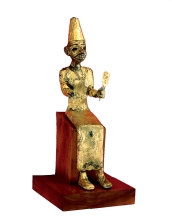
The study of Canaanite deities in connection with Yahweh was made possible by the discovery of ancient texts, especially from the ancient city of Ugarit in 1929. Now called Ras Shamra, it is located on the coast of Syria.
The Ugaritic mythological texts feature the deities El, the aged and kindly patriarch of the pantheon. Asherah was his consort and queen mother of the divine family. Baal was the young storm-god and divine warrior. His sister was Anat, likewise a martial deity. They also mention a solar deity.
El was the creator of all things and was believed to be the father of all things. Over time, El’s name became the generic Semitic term for any god. El was the oldest of the gods. He was head of the divine council, and he was well respected for his wisdom and judgment. El’s home was in the mountains, far to the north, believed to be the source of the waters of the cosmos. El lived far away where the waters originated, up in the mountains. When the other gods want to consult with El, they must go to where El is.
The most significant epithet given to El was “the Bull El.” The mainstream interpretation is that the name symbolized strength, but I think it had more to do astrological Age of Taurus when the god was popular. His consort was his sister, the mother of the god Ashura or Elat. El’s other sister, Astarte, was also his mistress, and so was his daughter Anat, who is also the wife of his son, Baal. The divine relationships show plenty of incest and a lot of fertility.

El also appears as a divine warrior, but only in the context of gaining supremacy over the other gods. Once he becomes dominant among equals, he retires from warfare and the work of divine warrior falls to Baal (right). Baal also sits at El’s right hand in the council of gods. Baal was initially a god of the storm who made the earth fertile by providing rain. The name of Baal means “Lord or master.” And like El, the name of Baal became a generic identification for gods. Sometime in the murkiness of Israelite history, the Israelite cult of Yahweh arose as belief in El faded.
Hebrew origins of yahweh
To hear the monotheists (Christian, Jewish; Islam) tell it, there was one god who created the universe — theirs. The way the Bible tells it, there were many gods responsible for the origins of the universe. We learn this by translating to Hebrew. “El” is the singular for god and “elohim” is its plural form. Thus in the first creation story:
1In the beginning God [Elohim] created the heavens and the earth.(Gen. 1:1)
26Then God [Elohim] said, “Let us make man in our image, after our likeness; and let them have dominion over the fish of the sea, and over the birds of the air, and over the cattle, and over all the earth, and over every creeping thing that creeps upon the earth.”(Gen. 1:26)
The name “Yahweh” first appears in the second creation story, but as Yahweh elohim, meaning “Yahweh of the gods.” If this is to be interpreted as a continuation of the first creation, then it is about one of the gods, Yahweh, who created a particular place, Eden, within the greater universe.
4These are the generations of the heavens and the earth when they were created. In the day that the LORD [Yahweh] God [elohim] made the earth and the heavens,
5when no plant of the field was yet in the earth and no herb of the field had yet sprung up—for the LORD [Yahweh] God [elohim] had not caused it to rain upon the earth, and there was no man to till the ground; (Gen. 2:4-5)
The story of Noah’s Ark has two different writers, scholars call “J” and “E.”
5The LORD [Yahweh] saw that the wickedness of man was great in the earth, and that every imagination of the thoughts of his heart was only evil continually. (Gen. 6:5)
13And God [Elohim] said to Noah, “I have determined to make an end of all flesh; for the earth is filled with violence through them; behold, I will destroy them with the earth. (Gen. 6:13)
Genesis 15:11 asks “Who is like you among the gods.”
11“Who is like thee, O LORD [Yahweh], among the gods? (Gen. 15:11)
And of course there are the famous words of the First Commandment, “You shall have no other gods before me.”
3“You shall have no other gods before me. (Gen. 20:1)
Christian apologists try to have it both ways by saying that the plural refers to the Holy Trinity. To do that they would have to ignore the pluralisms, alien gods, and pantheon of lesser gods mentioned throughout the Bible. Clearly, the early Hebrews were henotheists who recognized the existence of many gods.
From El to Yahweh
As suggestive by the “El” in the name “Israel,” the original god of Israel was El. Why this is likely is because there are no polemics against El. There is no distinct cult identified with El except when identified as Yahweh. As the Bible tells us “Semite” comes from Shem, Noah’s oldest son (Gen. 5:32) and “Hebrew” is derived from Eber, a descendant of Shem (Gen. 10:21). Incidentally, Babylonia comes from bili, meaning “gate of God.”
Most times, “El” and “Elohim” are used as a general term for god. But there are a few passages where “El” and “Elohim” are used as proper names.
El is presented separately from Yahweh. El Shadday means “El of the mountain,” not El Almighty as the revisionists translate in the Bible. Similar to El, Yahweh was thought to live on a mountaintop. It brings to mind, Moses’ visit to Mount Sinai to receive the Ten Commandments.
18I wait for thy salvation, O LORD [Yahweh].
24yet his bow remained unmoved, his arms were made agile by the hands of the Mighty One of Jacob (by the name of the Shepherd, the Rock of Israel),
25by the God [El] of your father who will help you, by God Almighty [shadday] who will bless you with blessings of heaven above, blessings of the deep that couches beneath, blessings of the breasts and of the womb. (Gen. 49:18, 24-25)
Yahweh is cast as one of the sons of El, called elyon here. He has portioned the land allotted to Jacob. At first Yahweh co-existed with the Canaanite gods, but later competed as a warrior god. There is a kind of a parallel in several Bible stories where brothers become rivals and the namesakes of competing geographies.
8When the Most High [elyon] gave to the nations their inheritance, when he separated the sons of men, he fixed the bounds of the peoples according to the number of the sons of God.
9For the LORD’S [Yahweh] portion is his people, Jacob his allotted heritage. (Deut. 32:8-9)
El has taken his place in the divine council as the one who holds judgment.
1God [Elohim] has taken his place in the divine council; in the midst of the gods [elohim] he holds judgment: (Psalm 82:1)
Isaiah refers to the stars of El.
13You said in your heart, ‘I will ascend to heaven; above the stars of God [El] I will set my throne on high; I will sit on the mount of assembly in the far north; (Isaiah 14:13)
El and Yahweh are distinguished as two different gods, with El as the superior. El Elohim means El of the gods, not mighty God—the translators mislead.
1The mighty [El] God [Elohim], even the LORD [Yahweh], hath spoken, and called the earth from the rising of the sun unto the going down thereof. (Psalm 50:1)
The Bible rarely distinguishes between El and Yahweh. The development of El into a generic noun meaning “god” was compatible with the loss of El’s distinct character in Israelite religion.
22The LORD [Yahweh] God [El] of gods [elohim], the LORD God of gods, he knoweth, and Israel he shall know; if it be in rebellion, or if in transgression against the LORD, (save us not this day,) (Joshua 22:22 KJV)
12Arise, O LORD [Yahweh]; O God [El], lift up thine hand: forget not the humble. (Psalm 10:12 KJV)
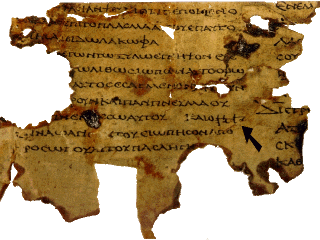
When Yahweh introduces himself to Moses, he reveals the fact that he was unknown to Abraham, Isaac and Jacob. Instead, they worshipped El Shadday, El of the mountain.
2And God [Elohim] said to Moses, “I am the LORD [Yahweh].
3I appeared to Abraham, to Isaac, and to Jacob, as God [El] Almighty [Shadday], but by my name the LORD [Yahweh] I did not make myself known to them. (Ex. 6:2-3)
Joshua remarks that the father of Abraham served other gods. It only stands to reason that Abraham did too.
2And Joshua said to all the people, “Thus says the LORD [Yahweh], the God [Elohim] of Israel, ‘Your fathers lived of old beyond the Euphrates, Terah, the father of Abraham and of Nahor; and they served other gods [elohim]. (Joshua 24:2)
Ezekiel tells us that the Yahwistic god was inherited from the Canaanites.
3and say, Thus says the Lord GOD [Yahweh] to Jerusalem: Your origin and your birth are of the land of the Canaanites; your father was an Amorite, and your mother a Hittite. (Ezek. 16:3)
Compare this sampling of biblical and Ugarit text. The tent and holy hill refer to the sky—the stars rise and fall in an arc pattern. The circle above the earth refers to the Zodiac.
Yahweh dwells in a tent.
1O LORD, who shall sojourn in thy tent? Who shall dwell on thy holy hill? (Psalm 15:1)
22It is he who sits above the circle of the earth, and its inhabitants are like grasshoppers; who stretches out the heavens like a curtain, and spreads them like a tent to dwell in; (Isa. 40:22)
El lives in a tent
She opened El’s tent and entered
the shrine of the King, the Father of Time.
Baal and Yahweh
We’re going to compare more biblical text with similar Ugarit text. These are the early years of the Israelite religion when Yahweh was a local god. The point is to show how early Judaism imitated Canaanite religion.
Yahweh was thought as a storm god. He brings rain, wind and lightening.
18So Samuel called upon the LORD, and the LORD sent thunder and rain that day; and all the people greatly feared the LORD and Samuel. (1 Sam. 12:18)
25“Who has cleft a channel for the torents of rain, and a way for the thunderbolt,
26to bring rain on a land where no man is, on the desert in which there is no man;
27to satisfy the waste and desolate land, and to make the ground put forth grass? (Job 38:25-27)
3The voice of the LORD is upon the waters; the God of glory thunders, the LORD, upon many waters.
4The voice of the LORD is powerful, the voice of the LORD is full of majesty.
5The voice of the LORD breaks the cedars, the LORD breaks the cedars of Lebanon.
6He makes Lebanon to skip like a calf, and Sirion like a young wild ox.
7The voice of the LORD flashes forth flames of fire.
8The voice of the LORD shakes the wilderness, the LORD shakes the wilderness of Kadesh.
9The voice of the LORD makes the oaks to whirl, and strips the forests bare; and in his temple all cry, “Glory!” (Psalm 29:3-9)
13When he utters his voice there is a tumult of waters in the heavens, and he makes the mist rise from the ends of the earth. He makes lightnings for the rain, and he brings forth the wind from his storehouses. (Jer. 10:13)
22Are there any among the false gods of the nations that can bring rain? Or can the heavens give showers? Art thou not he, O LORD our God? We set our hope on thee, for thou doest all these things. (Jer. 14:22)
7“And I also withheld the rain from you when there were yet three months to the harvest; I would send rain upon one city, and send no rain upon another city; one field would be rained upon, and the field on which it did not rain withered; (Amos 4:7)
Baal controls the weather.
Now Baal will begin the rainy season,
the season of the wadis in flood;
and he will sound his voice in the clouds,
flash his lightening to the earth.
Yahweh the divine warrior rides on the clouds.
3The LORD is a man of war; the LORD is his name. (Ex. 15:3)
1The Mighty One, God the LORD, speaks and summons the earth from the rising of the sun to its setting.
2Out of Zion, the perfection of beauty, God shines forth.
3Our God comes, he does not keep silence, before him is a devouring fire, round about him a mighty tempest. (Psalms 50:1-3)
13The LORD goes forth like a mighty man, like a man of war he stirs up his fury; he cries out, he shouts aloud, he shows himself mighty against his foes. (Isa. 42:13)
4Sing to God, sing praises to his name; lift up a song to him who rides upon the clouds; his name is the LORD, exult before him! (Psalm 68:4)
Baal was portrayed as a conqueror who rides on the clouds.
Hail, Baal the Conqueror!
Hail, Rider on the Clouds!
For Prince of the Sea is our Captive,
Judge River is our captive.
-287x400.jpg)
11Thou crownest the year with thy bounty; the tracks of thy chariot drip with fatness (Psalm 65:11)
3who hast laid the beams of thy chambers on the waters, who makest the clouds thy chariot, who ridest on the wings of the wind,
4who makest the winds thy messengers, fire and flame thy ministers. (Psalm 104:3-4)
8Was thy wrath against the rivers, O LORD? Was thy anger against the rivers, or thy indignation against the sea, when thou didst ride upon thy horses, upon thy chariot of victory? (Psalm 104:8)
8 Was thy wrath against the rivers, O LORD? Was thy anger against the rivers, or thy indignation against the sea, when thou didst ride upon thy horses, upon thy chariot of victory? (Hab. 3:8)
If the clouds are Yahweh’s chariot, it is the sun which rides on the clouds. This is similar to pagan imagery where the sun is thought of as riding on a chariot. This verse refers to the chariots of the sun.
11And he removed the horses that the kings of Judah had dedicated to the sun, at the entrance to the house of the LORD, by the chamber of Nathan-melech the chamberlain, which was in the precincts; and he burned the chariots of the sun with fire. (2 Kings 23:11)
Ancients thought of the sun as a wheel turning through the heavens. This gives meaning to Elijah’s ascent into heaven.
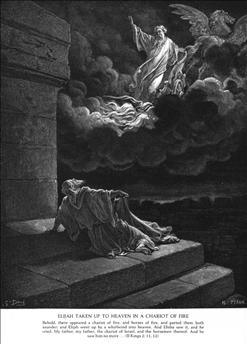
11And as they still went on and talked, behold, a chariot of fire and horses of fire separated the two of them. And Elijah went up by a whirlwind into heaven. (2 Kings 11)
In another imagery, the sun is thought here of as Yahweh’s shield and face.
11For the LORD God is a sun and shield; he bestows favor and honor. No good thing does the LORD withhold from those who walk uprightly. (Psalm 84:11)
9Behold our shield, O God; look upon the face of thine anointed! (Psalm 84:9)
2My soul thirsts for God, for the living God. When shall I come and behold the face of God? (Psalm 42:2)
During later times Ezekiel was critical of the Israelites who continued to worship the sun. The legacy of sun worship can be found in the place names with Shemesh attached, the name of the Babylonian sun god (Josh. 15:7, 10, 18:17, 19:41 & 21:16).
16And he brought me into the inner court of the house of the LORD; and behold, at the door of the temple of the LORD, between the porch and the altar, were about twenty-five men, with their backs to the temple of the LORD, and their faces toward the east, worshiping the sun toward the east. (Ez. 8:16)
In Ugarit text, the sun is depicted as the gods’ torch.
And the Virgin Anat replied:
“Wherever you go Sun,
wherever you go, may El protect you.
Sun, the gods’ torch, burns
the heavens shimmer under the sway of El’s darling,
Death.
Yahweh has a sanctuary in Sinai.
2He said, “The LORD came from Sinai, and dawned from Seir upon us; he shone forth from Mount Paran, he came from the ten thousands of holy ones, with flaming fire at his right hand. (Deut. 33:2)
5The mountains quaked before the LORD, yon Sinai before the LORD, the God of Israel. (Jud. 5:5)
17With mighty chariotry, twice ten thousand, thousands upon thousands, the Lord came from Sinai into the holy place. (Psalm 68:17)
Baal had a home on Mount Zaphon.
Baal’s mountain, father, we weep for you,
Zaphon, the holy stronghold,
the holy stronghold will lament,
the stronghold wide and strong.
Watch the imagery in Exodus 19 when Moses enters the holy mountain of Sinai, to receive the Ten Commandments.
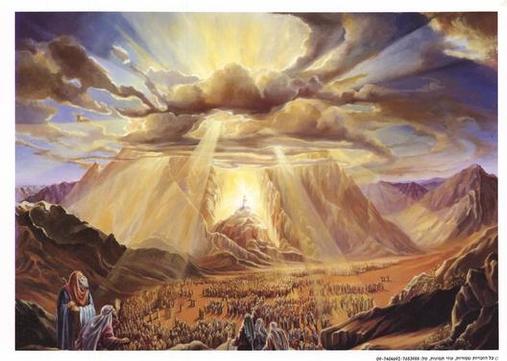
16On the morning of the third day there were thunders and lightnings, and a thick cloud upon the mountain, and a very loud trumpet blast, so that all the people who were in the camp trembled.
17Then Moses brought the people out of the camp to meet God; and they took their stand at the foot of the mountain.
18And Mount Sinai was wrapped in smoke, because the LORD descended upon it in fire; and the smoke of it went up like the smoke of a kiln, and the whole mountain quaked greatly. (Ex. 19:16-18)
The Baal imagery is similar
Then Baal opened a slit in the clouds,
Baal sounded his holy voice,
Baal thundered from his lips …
the earth’s high places shook.
Abraham’s anachronism
Abraham, the Hebrew patriarch, comes to our knowledge as a nomadic Chaldean Semite from Ur (map below). The first documented reference to “Chaldea” is found in the annals of Ashurnasirpal II, king of Assyria form 884 to 859 BCE. As we shall see, there was no Chaldea at the time Abraham.
Abraham’s (Abram) father had intended to take his family to Canaan but stopped at Haran.
31Terah took Abram his son and Lot the son of Haran, his grandson, and Sarai his daughter-in-law, his son Abram’s wife, and they went forth together from Ur of the Chaldeans to go into the land of Canaan; but when they came to Haran, they settled there. (Gen. 11:31)
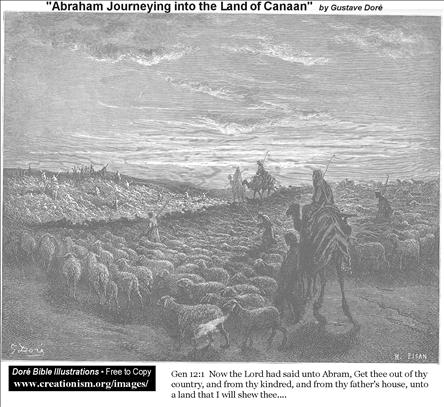
1Now the LORD [Yahweh] said to Abram, “Go from your country and your kindred and your father’s house to the land that I will show you. (Gen. 12:1)
At face value alone, Abraham would have had to have spoken the Babylonian language and initially worshipped the same pagan gods. Joshua makes that point.
2And Joshua said to all the people, “Thus says the LORD [Yahweh], the God [Elohim] of Israel, ‘Your fathers lived of old beyond the Euphrates, Terah, the father of Abraham and of Nahor; and they served other gods [elohim]. (Joshua 24:2)
To regress, some background history will give a sense of the influences felt in Israel. “Mesopotamia” in Greek means “Between the Rivers.” In the ancient world, northern Upper Mesopotamia referred to Assyria. The southern Lower Mesopotamia included Babylon itself and the cities of the earliest kingdoms of Akkad and Sumer. Ur is located at the junction of the Tigress-Euphrates where they flow into the Persian Gulf.
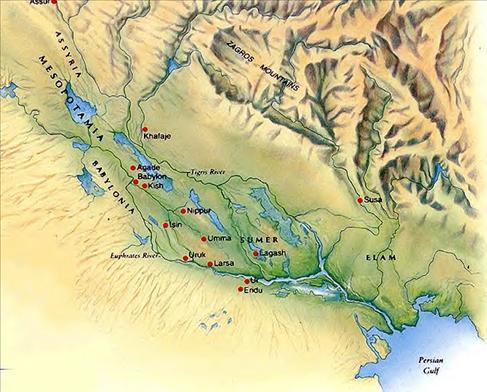
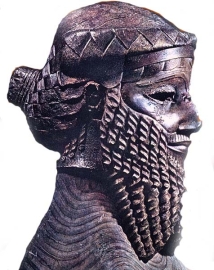
The people of the city of Sumer, the Sumerians became dominant around 3100 BCE; they were followed about two centuries later by the Amorites who settled to the north of the Sumerians in what is now Baghdad. The first kings were Akkadian, descendents of the Semitic Amorites. The first great king of Mesopotamia was Sargon the Great (left) who ruled from 2334 BCE to 2279 BCE. At the end of his time, Akkad sank into obscurity with the return of the Sumerians into supremacy.
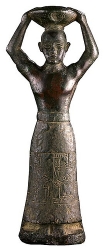
Their supremacy was established by a king named Ur-Nammu around 2111 BCE. Known as the third dynasty of Ur, it lasted about one century until the city of Ur was devastated by a group from the east called the Elamites in 2004 BCE. It is my personal guess that this is where Ur got its name. Kings don’t take their name from cities, they name cities after themselves.

Babylon, the next city-state to rise to dominance, was formally Akkadian. Its first great king, Hammurabi dated from 1792 to 1750 BCE. Hammurabi is best remembered for his law code which was written on a stele topped by a depiction of Hammurabi himself before the sun god, Shamash. But he was not the first to write a law code—that was Ur-Nammu. Contrary to biblical myth, the Ten Commandments were not the first law code. Rather, the Hebrews copied their neighbors.
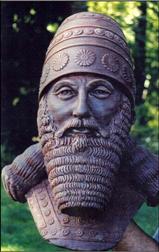
In the centuries that followed, Mesopotamia was invaded by non-Semitics from the west, Hittites, Hurians and Kassites. From the upper Tigris valley, another Semitic people, the Assyrians came to prominence over Mesopotamia under Tukulti-Ninurta I, who sacked the city of Babylon in 1235 BCE—thereby asserting his sovereignty over the south. The Bible calls him Nimrod (Gen. 10:8-10).
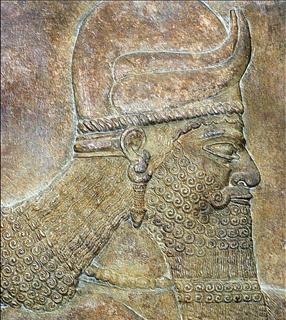
The first reference to Chaldea is found in the annals of Ashurnasirpal II (left), king of Assyria from 884 to 859 BCE. The last great king of Assyria was Assurbanipal, whose dates are 669 to 627 BCE. The Assyrians were dismantled by the Medians to the northeast and by the Kaldians (Chaldeans) or neo-Babylonians.

Their first great king (604-562 BCE) was none other than Nebuchadnezzar (right) of Jewish exile fame. Early Chaldea referred to southern Babylon. In later times, Chaldea became synonymous with the Babylonian Empire. The Chaldean dynasty held sway until the Persian invasion of 539 BCE.
8Therefore at that time certain Chaldeans came forward and maliciously accused the Jews.
9They said to King Nebuchadnezzar, “O king, live for ever! (Dan. 3:8-9)
The link between Ur and Chaldea gives away when the story of Abraham was written. While Ur was certainly an ancient city, Chaldea did not become prominent until the seventh century under Nebuchadnezzar. By biblical accounts, Abraham existed from 2046-2100 BCE and the Chaldeans didn’t exist until the 600s. Why? Ur was renowned as a place of learning during Chaldean times, especially to astrology. It would have enhanced Abraham's prestige to come from such a place.
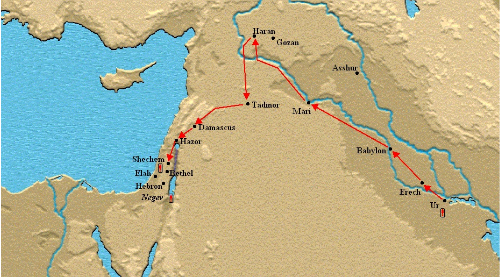
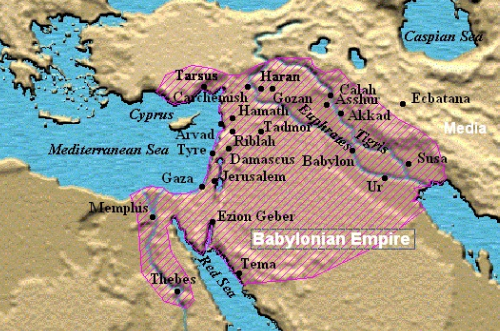
This is a list of most other anachronisms.
Abraham is said to have contact with Philistines, but they did not enter the Palestine area before 12 BCE. According to Finkelstein, author of The Bible Unearthed: Archaeology's New Vision of Ancient Israel and the Origin of Its Sacred Texts, the mention of Gerar had a special significance. It was an insignificant village until the late eighth and seventh century BCE when it became a heavily fortified Assyrian stronghold and an obvious landmark.
1Now there was a famine in the land, besides the former famine that was in the days of Abraham. And Isaac went to Gerar, to Abimelech king of the Philistines. (Gen. 26:1)
Arameans are mentioned, but they did not appear as a distinct group before 1100 BCE.
19These are the descendants of Isaac, Abraham’s son: Abraham was the father of Isaac,
20and Isaac was forty years old when he took to wife Rebekah, the daughter of Bethuel the Aramean of Paddanaram, the sister of Laban the Aramean. (Gen. 25:19-20)
The story of Jacob and Esau describes the fathers of Israel and Edom, but there was no state of Edom before the eighth century BCE.
23And the LORD said to her, “Two nations are in your womb, and two peoples, born of you, shall be divided; the one shall be stronger than the other, the elder shall serve the younger.”
30And Esau said to Jacob, “Let me eat some of that red pottage, for I am famished!” (Therefore his name was called Edom. (Gen. 25:23, 30)
There are many mentions of domesticated camels, but as far as anyone can tell, camels were not domesticated much before the first millennium BCE, about the time when the kingdom of Israel was founded.
11And he made the camels kneel down outside the city by the well of water at the time of evening, the time when women go out to draw water.
12And he said, “O LORD, God of my master Abraham, grant me success today, I pray thee, and show steadfast love to my master Abraham. (Gen. 24:11-12)
The story of Joseph mentions camel caravan trade with the Ishmaelites (Arabians). Trade on that level flourished during the Assyrian empire in the eighth-seventh centuries BCE.
25Then they sat down to eat; and looking up they saw a caravan of Ishmaelites coming from Gilead, with their camels bearing gum, balm, and myrrh, on their way to carry it down to Egypt. (Gen. 37:25)
Hebron was a principal city of Judah, so the writer has Abraham build an altar in Hebron
18So Abram moved his tent, and came and dwelt by the oaks of Mamre, which are at Hebron; and there he built an altar to the LORD. (Gen. 13:18)
This passage describes the nation’s boundaries under King David, written with hindsight.
18On that day the LORD made a covenant with Abram, saying, “To your descendants I give this land, from the river of Egypt to the great river, the river Euphrates, (Gen. 15:18)
Jacob saw God face to face at Peniel, a city built by King Jeroboam in Israel.
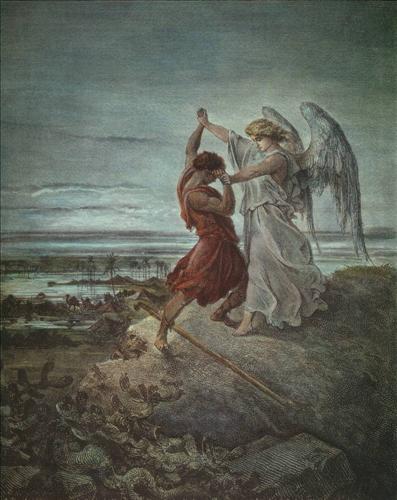
30So Jacob called the name of the place Peniel, saying, “For I have seen God face to face, and yet my life is preserved.” (Gen. 32:30)
For these reasons and more, Finkelstein places writing of the patriarch narratives in the eighth and seventh centuries BCE. This is not one man’s opinion. There are probably some religious archeologists who refuse to concede, but the sources I’ve found are in general agreement. Friedman, author of Who Wrote the Bible?, tells us that scholars have given these writers alphabet names: “J” for Yahweh and “E for Elohim. There were others, but these two are the ones we are concerned with. Friedman dates them between 1200-722 BCE when there were two kingdoms. Even as generous as Friedman is, that still leaves a thousand year difference between when Abraham supposedly lived and when Genesis was written. I could go through the same exercise with Moses and the Exodus. Instead, I’ll pass on the words of Michael Dever, author of Who Were the Early Israelites and Where Did They Come From?
:
"After a century of exhaustive investigation, all respectable archaeologists have given up hope of recovering any context that would make Abraham, Isaac, or Jacob credible “historical figures.” And, as we have seen, archaeological investigation of Moses and the Exodus has similarly been discarded as a fruitless pursuit."
The development of Israelite monotheism
In the second stage, the condemnation of foreign gods brings with it the implication that Yahweh has power over them. The trend starts with 1 Kings 18, which tells the story of Elijah who challenged the Baal priests to a contest to see which god could make wet wood burn. When Elijah won he had the priests killed.
These next three passages suggest Yahweh has power over other nations.
24The LORD of hosts has sworn: “As I have planned, so shall it be, and as I have purposed, so shall it stand,
25that I will break the Assyrian in my land, and upon my mountains trample him under foot; and his yoke shall depart from them, and his burden from their shoulder.”
26This is the purpose that is purposed concerning the whole earth; and this is the hand that is stretched out over all the nations. (Isa. 14:24-26)
1An oracle concerning Egypt. Behold, the LORD is riding on a swift cloud and comes to Egypt; and the idols of Egypt will tremble at his presence, and the heart of the Egyptians will melt within them. (Isa. 19:1)
The concept of a supernatural heaven was developed sometime after the Bible was written. Ancients perceived the gods living in physical heaven.
2Why should the nations say, “Where is their God?”
3Our God is in the heavens; he does whatever he pleases.
4Their idols are silver and gold, the work of men’s hands.
5They have mouths, but do not speak; eyes, but do not see.
6They have ears, but do not hear; noses, but do not smell.
7They have hands, but do not feel; feet, but do not walk; and they do not make a sound in their throat.
8Those who make them are like them; so are all who trust in them. (Psalm 115:2-8)
Several verses are critical of the emptiness of idol worship.
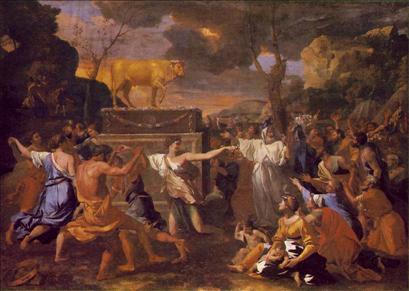
6Thou hatest those who pay regard to vain idols; but I trust in the LORD. (Psalm 31:6)
18To whom then will you liken God, or what likeness compare with him?
19The idol! a workman casts it, and a goldsmith overlays it with gold, and casts for it silver chains.
20He who is impoverished chooses for an offering wood that will not rot; he seeks out a skilful craftsman to set up an image that will not move. (Isa. 40:18-20)
18And the idols shall utterly pass away.
19And men shall enter the caves of the rocks and the holes of the ground, from before the terror of the LORD, and from the glory of his majesty, when he rises to terrify the earth. (Isa. 2:18)
9All who make idols are nothing, and the things they delight in do not profit; their witnesses neither see nor know, that they may be put to shame.
10Who fashions a god or casts an image, that is profitable for nothing?
11Behold, all his fellows shall be put to shame, and the craftsmen are but men; let them all assemble, let them stand forth, they shall be terrified, they shall be put to shame together. (Isa. 44:9-11)
13When you cry out, let your collection of idols deliver you! The wind will carry them off, a breath will take them away. But he who takes refuge in me shall possess the land, and shall inherit my holy mountains. (Isa. 57:13)
10Have we not all one father? Has not one God created us? Why then are we faithless to one another, profaning the covenant of our fathers? (Mal. 2:10)
It wasn’t until the exile or shortly beforehand when Judaism turned monotheistic, i.e. Yahweh was the only deity in the universe. This is dramatically stressed in second Isaiah and Jeremiah.
5I am the LORD, and there is no other, besides me there is no God; I gird you, though you do not know me,
6that men may know, from the rising of the sun and from the west, that there is none besides me; I am the LORD, and there is no other.
7I form light and create darkness, I make weal and create woe, I am the LORD, who do all these things. (Isa. 45:5-7)
8“Remember this and consider, recall it to mind, you transgressors,
9remember the former things of old; for I am God, and there is no other; I am God, and there is none like me,
10declaring the end from the beginning and from ancient times things not yet done, saying, ‘My counsel shall stand, and I will accomplish all my purpose,’ (Isa. 46:8-10)
10But the LORD is the true God; he is the living God and the everlasting King. At his wrath the earth quakes, and the nations cannot endure his indignation.
11Thus shall you say to them: “The gods who did not make the heavens and the earth shall perish from the earth and from under the heavens.”
12It is he who made the earth by his power, who established the world by his wisdom, and by his understanding stretched out the heavens.
13When he utters his voice there is a tumult of waters in the heavens, and he makes the mist rise from the ends of the earth. He makes lightnings for the rain, and he brings forth the wind from his storehouses.
14Every man is stupid and without knowledge; every goldsmith is put to shame by his idols; for his images are false, and there is no breath in them.
15They are worthless, a work of delusion; at the time of their punishment they shall perish. (Jer. 10:10-15)
Conclusion
That’s the general outline of the offshoot of the Biblical god from the Canaanite gods, from a local god to the most powerful god to the only God. This is the foundation of the development of the Christian God and the Islamic God.
![]()
![]()
Disclaimer:
Some material presented will contain links, quotes, ideologies, etc., the contents of which should be understood to first, in their whole, reflect the views or opinions of their editors, and second, are used in my personal research as "fair use" sources only, and not espousement one way or the other. Researching for 'truth' leads one all over the place...a piece here, a piece there. As a researcher, I hunt, gather and disassemble resources, trying to put all the pieces into a coherent and logical whole. I encourage you to do the same. And please remember, these pages are only my effort to collect all the pieces I can find and see if they properly fit into the 'reality aggregate'.
Personal Position:
I've come to realize that 'truth' boils down to what we 'believe' the facts we've gathered point to. We only 'know' what we've 'experienced' firsthand. Everything else - what we read, what we watch, what we hear - is what someone else's gathered facts point to and 'they' 'believe' is 'truth', so that 'truth' seems to change in direct proportion to newly gathered facts divided by applied plausibility. Though I believe there is 'truth', until someone representing the celestial realm visibly appears and presents the heavenly records of Facts And Lies In The Order They Happened, I can't know for sure exactly what "the whole truth' on any given subject is, and what applies to me applies to everyone. Until then I'll continue to ask, "what does The Urantia Book say on the subject?"
~Gail Bird Allen
![]()
![]()

